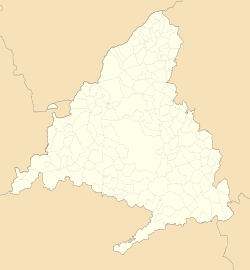Guadarrama
Guadarrama
|
||
|---|---|---|
| Municipality | ||
|
||
| Location of Guadarrama within Spain / Navarre | ||
| Coordinates: 40°40′22″N 4°05′20″W / 40.67278°N 4.08889°WCoordinates: 40°40′22″N 4°05′20″W / 40.67278°N 4.08889°W | ||
| Country |
|
|
| Autonomous Community |
|
|
| Comarca | Cuenca del Guadarrama | |
| Municipality | Guadarrama | |
| Government | ||
| • Mayor | Carmen María Pérez del Molino (APPG) | |
| Area | ||
| • Total | 56.98 km2 (22.00 sq mi) | |
| Elevation | 981 m (3,219 ft) | |
| Population (2015) | ||
| • Total | 15,538 | |
| • Density | 270/km2 (710/sq mi) | |
| Demonym(s) | guadarrameño, -ña | |
| Website | Guadarrama's Town Council | |
Guadarrama is a town and municipality in the Cuenca del Guadarrama comarca, in the Community of Madrid, Spain.
Pop: 13032 (winter, 2006 census), approx. 60000 (summer).
Founded by Arabs, its name comes from uadi-er-rameil river.
Guadarrama achieved the status of "villa" under Fernando V of Castile (II of Aragon) on November 22, 1504. Fernando VI ordered the building of a road to A Coruña through the Puerto de Guadarrama, by which it passed in 1808 the Grande Armée with Napoleon searching the Moore's Army.
This town was absolutely destroyed in the Spanish Civil War, as it was for almost three years battlefront, all today can see in this town is new, of mid-20th century.
It was the location for some scenes in the 1964 film The Fall of the Roman Empire.
It is close to Sierra de Guadarrama, a mountain range that is visited by Madrid residents seeking colder temperatures.
...
Wikipedia



